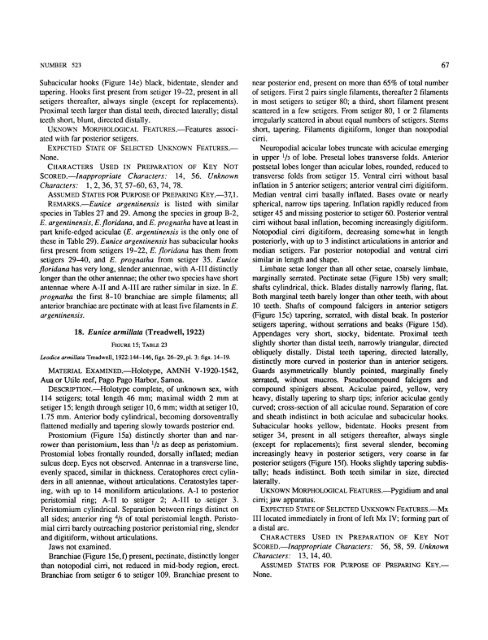A Review of the Genus Eunice - Smithsonian Institution Libraries
A Review of the Genus Eunice - Smithsonian Institution Libraries
A Review of the Genus Eunice - Smithsonian Institution Libraries
You also want an ePaper? Increase the reach of your titles
YUMPU automatically turns print PDFs into web optimized ePapers that Google loves.
NUMBER 523 67<br />
Subacicular hooks (Figure 14e) black, bidentate, slender and<br />
tapering. Hooks first present from setiger 19-22, present in all<br />
setigcrs <strong>the</strong>reafter, always single (except for replacements).<br />
Proximal teeth larger than distal teeth, directed laterally; distal<br />
teeth short, blunt, directed distally.<br />
UKNOWN MORPHOLOGICAL FEATURES.—Features associated<br />
with far posterior sctigers.<br />
EXPECTED STATE OF SELECTED UNKNOWN FEATURES.—<br />
None.<br />
CHARACTERS USED IN PREPARATION OF KEY NOT<br />
SCORED.—Inappropriate Characters: 14, 56. Unknown<br />
Characters: 1, 2, 36, 37, 57-60, 63, 74, 78.<br />
ASSUMED STATES FOR PURPOSE OF PREPARING KEY.—37,1.<br />
REMARKS.—<strong>Eunice</strong> argentinensis is listed with similar<br />
species in Tables 27 and 29. Among <strong>the</strong> species in group B-2,<br />
E. argentinensis, E.floridana, and E. prognatha have at least in<br />
part knife-edged aciculae (£. argentinensis is <strong>the</strong> only one <strong>of</strong><br />
<strong>the</strong>se in Table 29). <strong>Eunice</strong> argentinensis has subacicular hooks<br />
first present from setigers 19-22, E. floridana has <strong>the</strong>m from<br />
setigers 29-40, and E. prognatha from setiger 35. <strong>Eunice</strong><br />
floridana has very long, slender antennae, with A-III distinctly<br />
longer than <strong>the</strong> o<strong>the</strong>r antennae; <strong>the</strong> o<strong>the</strong>r two species have short<br />
antennae where A-II and A-III are ra<strong>the</strong>r similar in size. In E.<br />
prognatha <strong>the</strong> first 8-10 branchiae are simple filaments; all<br />
anterior branchiae are pectinate with at least five filaments in E.<br />
argentinensis.<br />
18. <strong>Eunice</strong> armillata (Treadwell, 1922)<br />
FIGURE 15; TABLE 23<br />
Leodice armillata Treadwell, 1922:144-146, figs. 26-29, pi. 3: figs. 14-19.<br />
MATERIAL EXAMINED.—Holotype, AMNH V-1920-1542,<br />
Aua or Utile reef, Pago Pago Harbor, Samoa.<br />
DESCRIPTION.—Holotype complete, <strong>of</strong> unknown sex, with<br />
114 setigers; total length 46 mm; maximal width 2 mm at<br />
setiger 15; length through setiger 10,6 mm; width at setiger 10,<br />
1.75 mm. Anterior body cylindrical, becoming dorsoventrally<br />
flattened medially and tapering slowly towards posterior end.<br />
Prostomium (Figure 15a) distinctly shorter than and narrower<br />
than peristomium, less than l /2 as deep as peristomium.<br />
Prostomial lobes frontally rounded, dorsally inflated; median<br />
sulcus deep. Eyes not observed. Antennae in a transverse line,<br />
evenly spaced, similar in thickness. Ceratophores erect cylinders<br />
in all antennae, without articulations. Ceratostyles tapering,<br />
with up to 14 moniliform articulations. A-I to posterior<br />
peristomial ring; A-II to setiger 2; A-III to setiger 3.<br />
Peristomium cylindrical. Separation between rings distinct on<br />
all sides; anterior ring 4 /5 <strong>of</strong> total peristomial length. Peristomial<br />
cirri barely outreaching posterior peristomial ring, slender<br />
and digitiform, without articulations.<br />
Jaws not examined.<br />
Branchiae (Figure 15e,f) present, pectinate, distinctly longer<br />
than notopodial cirri, not reduced in mid-body region, erect.<br />
Branchiae from setiger 6 to setiger 109. Branchiae present to<br />
near posterior end, present on more than 65% <strong>of</strong> total number<br />
<strong>of</strong> setigers. First 2 pairs single filaments, <strong>the</strong>reafter 2 filaments<br />
in most setigers to setiger 80; a third, short filament present<br />
scattered in a few setigers. From setiger 80, 1 or 2 filaments<br />
irregularly scattered in about equal numbers <strong>of</strong> setigers. Stems<br />
short, tapering. Filaments digitiform, longer than notopodial<br />
cirri.<br />
Neuropodial acicular lobes truncate with aciculae emerging<br />
in upper 73 <strong>of</strong> lobe. Presetal lobes transverse folds. Anterior<br />
postsetal lobes longer than acicular lobes, rounded, reduced to<br />
transverse folds from setiger 15. Ventral cirri without basal<br />
inflation in 5 anterior setigers; anterior ventral cirri digitiform.<br />
Median ventral cirri basally inflated. Bases ovate or nearly<br />
spherical, narrow tips tapering. Inflation rapidly reduced from<br />
setiger 45 and missing posterior to setiger 60. Posterior ventral<br />
cirri without basal inflation, becoming increasingly digitiform.<br />
Notopodial cirri digitiform, decreasing somewhat in length<br />
posteriorly, with up to 3 indistinct articulations in anterior and<br />
median setigers. Far posterior notopodial and ventral cirri<br />
similar in length and shape.<br />
Limbate setae longer than all o<strong>the</strong>r setae, coarsely limbate,<br />
marginally serrated. Pectinate setae (Figure 15b) very small;<br />
shafts cylindrical, thick. Blades distally narrowly flaring, flat.<br />
Both marginal teeth barely longer than o<strong>the</strong>r teeth, with about<br />
10 teeth. Shafts <strong>of</strong> compound falcigers in anterior setigers<br />
(Figure 15c) tapering, serrated, with distal beak. In posterior<br />
setigers tapering, without serrations and beaks (Figure 15d).<br />
Appendages very short, stocky, bidentate. Proximal teeth<br />
slightly shorter than distal teeth, narrowly triangular, directed<br />
obliquely distally. Distal teeth tapering, directed laterally,<br />
distinctly more curved in posterior than in anterior setigers.<br />
Guards asymmetrically bluntly pointed, marginally finely<br />
serrated, without mucros. Pseudocompound falcigers and<br />
compound spinigers absent. Aciculae paired, yellow, very<br />
heavy, distally tapering to sharp tips; inferior aciculae gently<br />
curved; cross-section <strong>of</strong> all aciculae round. Separation <strong>of</strong> core<br />
and sheath indistinct in both aciculae and subacicular hooks.<br />
Subacicular hooks yellow, bidentate. Hooks present from<br />
setiger 34, present in all setigers <strong>the</strong>reafter, always single<br />
(except for replacements); first several slender, becoming<br />
increasingly heavy in posterior setigers, very coarse in far<br />
posterior setigers (Figure 150- Hooks slightly tapering subdistally;<br />
heads indistinct. Both teeth similar in size, directed<br />
laterally.<br />
UKNOWN MORPHOLOGICAL FEATURES.—Pygidium and anal<br />
cirri; jaw apparatus.<br />
EXPECTED STATE OF SELECTED UNKNOWN FEATURES.—Mx<br />
III located immediately in front <strong>of</strong> left Mx IV; forming part <strong>of</strong><br />
a distal arc.<br />
CHARACTERS USED IN PREPARATION OF KEY NOT<br />
SCORED.—Inappropriate Characters: 56, 58, 59. Unknown<br />
Characters: 13,14,40.<br />
ASSUMED STATES FOR PURPOSE OF PREPARING KEY.—<br />
None.
















